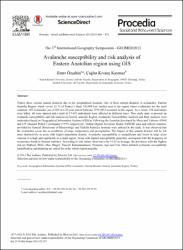| dc.contributor.author | Özşahin, Emre | |
| dc.contributor.author | Kaymaz, Çağlar Kıvanç | |
| dc.date.accessioned | 2022-05-11T14:29:26Z | |
| dc.date.available | 2022-05-11T14:29:26Z | |
| dc.date.issued | 2014 | |
| dc.identifier.issn | 1877-0428 | |
| dc.identifier.uri | https://doi.org/10.1016/j.sbspro.2014.02.147 | |
| dc.identifier.uri | https://hdl.handle.net/20.500.11776/6967 | |
| dc.description | 3rd International Geography Symposium (GEOMED) -- JUN 10-13, 2013 -- Antalya, TURKEY | en_US |
| dc.description.abstract | Turkey faces various natural disasters due to her geographical location. One of these natural disasters is avalanches. Eastern Anatolia Region which covers 21 % of Turkey's land, 163.000 km(2) surface area is the region where avalanches are the most common. 193 avalanches out of 220 in a 32-year period between 1970-2012 occurred in this region. As a result, 128 individuals were killed, 48 were injured and a total of 17.892 individuals were affected in different ways. This study aims to provide an avalanche susceptibility and risk analysis in Eastern Anatolia Region. Avalanche Susceptibility Analysis and Risk Analysis were undertaken based on Geographical Information Systems (GIS) by following the formulas developed by Mora and Vahrson (1994) and UN Disaster Relief Coordinator (1979) respectively. Global Digital Elevation Model (GDEM) data and official statistics provided by General Directorate of Meteorology and Turkish Statistics Institute were utilized in the study. It was observed that the avalanches occur due to conditions of slope, temperature and precipitation. The impact of this natural disaster will be felt more distinctively in areas with higher population density. Avalanche susceptibility is insignificant and lower in large areas whereas it is high and significant in a small region. Areas with highest susceptibility generally correspond with the frequency of occurrence found in disaster statistics. According to risk values observed to be 11.63 in average, the provinces with the highest risk are Hakkari, Bitlis, Mus, Bingol, Tunceli, Kahramanmaras, Erzurum, Agri and Van. More detailed avalanche susceptibility identification and planning are called for in the whole region urgently. (C) 2013 The Authors. Published by Elsevier Ltd. | en_US |
| dc.language.iso | eng | en_US |
| dc.publisher | Elsevier Science Bv | en_US |
| dc.identifier.doi | 10.1016/j.sbspro.2014.02.147 | |
| dc.rights | info:eu-repo/semantics/openAccess | en_US |
| dc.subject | Geographical Information Systems (GIS) | en_US |
| dc.subject | Avalanche | en_US |
| dc.subject | Natural Disaster | en_US |
| dc.subject | Eastern Anatolian Region | en_US |
| dc.subject | Turkey | en_US |
| dc.subject | Model | en_US |
| dc.title | Avalanche susceptibility and risk analysis of Eastern Anatolian region using GIS | en_US |
| dc.type | proceedingPaper | en_US |
| dc.relation.ispartof | 3rd International Geography Symposium, Geomed2013 | en_US |
| dc.department | Fakülteler, Fen Edebiyat Fakültesi, Coğrafya Bölümü | en_US |
| dc.authorid | 0000-0003-2313-870X | |
| dc.identifier.volume | 120 | en_US |
| dc.identifier.startpage | 663 | en_US |
| dc.identifier.endpage | 672 | en_US |
| dc.institutionauthor | Özşahin, Emre | |
| dc.relation.publicationcategory | Konferans Öğesi - Uluslararası - Kurum Öğretim Elemanı | en_US |
| dc.authorwosid | KAYMAZ, Çağlar Kıvanç/ABA-3261-2021 | |
| dc.authorwosid | ÖZŞAHİN, Emre/R-8807-2018 | |
| dc.identifier.wos | WOS:000335821200073 | en_US |



















